How Springboot integrates Dubbo projects and environment construction
1. Use IDEA to create a new Maven project
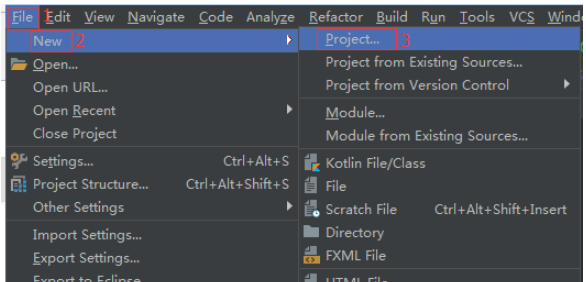
New project
After selecting Maven, click next
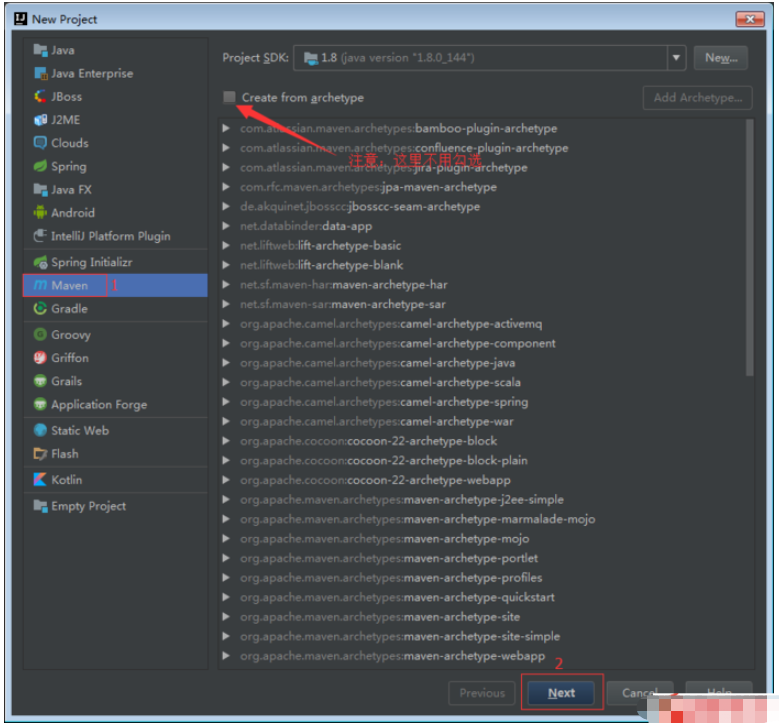
Select project type
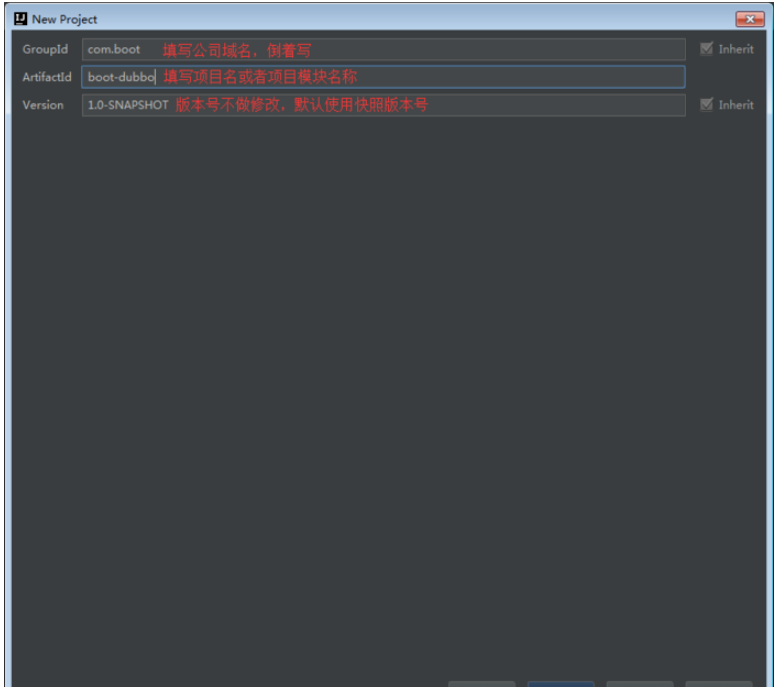
Configure the Maven coordinates of the project
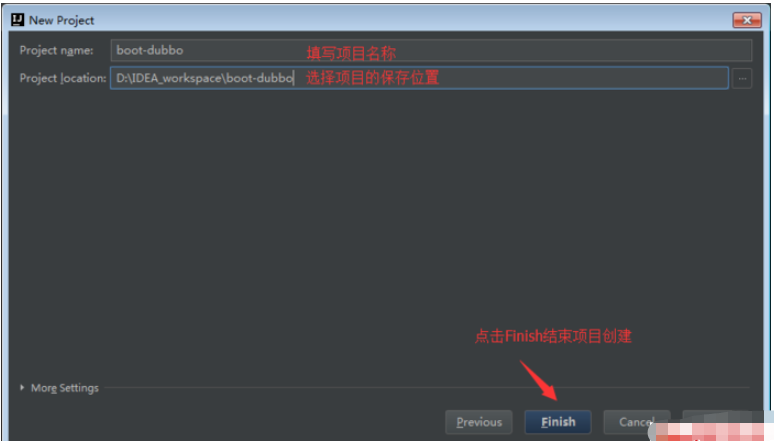
Set the project name and save location
Modify the project's pom.xml file
<?xml version="1.0" encoding="UTF-8"?> <project> <modelversion>4.0.0</modelversion> <groupid>com.boot</groupid> <artifactid>boot-dubbo</artifactid> <version>1.0-SNAPSHOT</version> <!--在这里设置打包类型为pom,作用是为了实现多模块项目--> <packaging>pom</packaging> </project>
2. Create a sub-module project of boot-dubbo
To create the Dubbo service interface project, we build the project under the boot-dubbo project we just created and manage it as a sub-module project of boot-dubbo.
Click on the newly created project we just created to create a new sub-module project of boot-dubbo
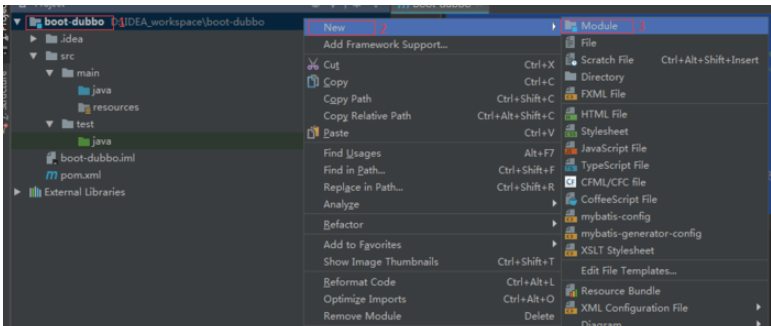
The sub-module project of the new project

Click next after selecting Maven
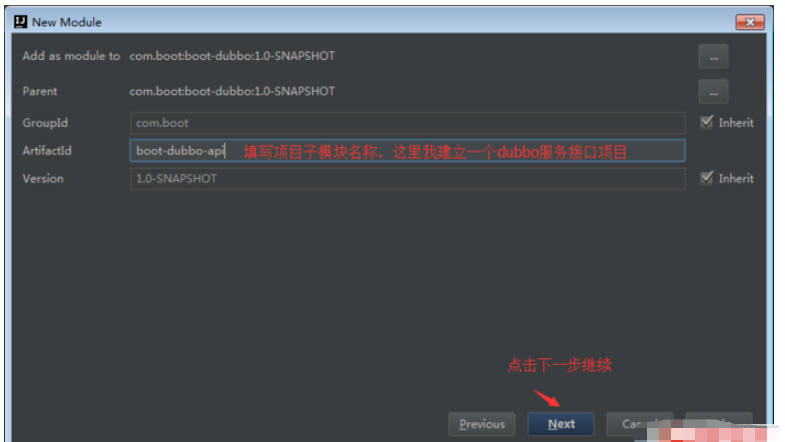
Configure module parameters
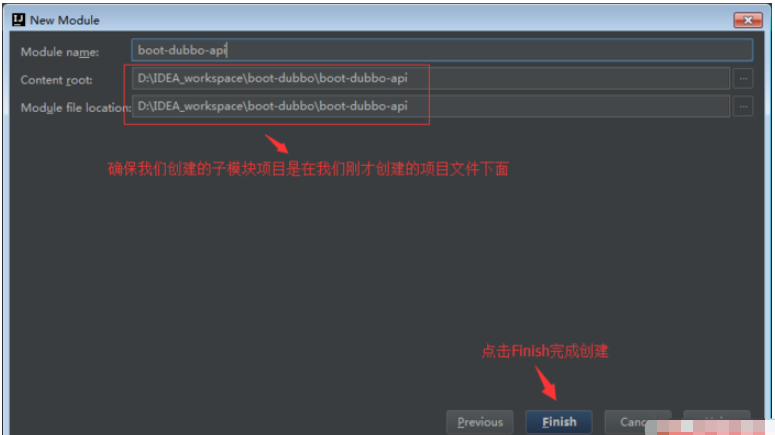
Complete the creation of project sub-modules
Similarly, we continue with our second step and create two sub-module projects, boot-dubbo-provider and boot-dubbo-consumer, again.
After the creation is completed, our overall project structure diagram is as shown below:
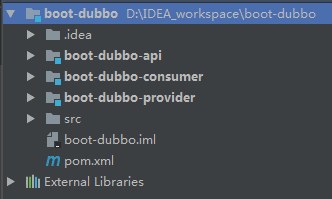
Project completion structure diagram
At this point, our preparations for creating the project have been completed.
3. Define the pom.xml file of each project
Open the pom.xml file of our top-level project boot-dubbo
<?xml version="1.0" encoding="UTF-8"?>
<project>
<modelversion>4.0.0</modelversion>
<groupid>com.boot</groupid>
<artifactid>boot-dubbo</artifactid>
<version>1.0-SNAPSHOT</version>
<!-- 这里是我们子模块的设置 -->
<modules>
<module>boot-dubbo-api</module>
<module>boot-dubbo-provider</module>
<module>boot-dubbo-consumer</module>
</modules>
<!-- 在这里设置打包类型为pom,作用是为了实现多模块项目 -->
<packaging>pom</packaging>
<!-- 第一步:添加Springboot的parent -->
<parent>
<groupid>org.springframework.boot</groupid>
<artifactid>spring-boot-starter-parent</artifactid>
<version>1.5.7.RELEASE</version>
</parent>
<!-- 设置我们项目的一些版本属性 -->
<properties>
<project.build.sourceencoding>UTF-8</project.build.sourceencoding>
<java.version>1.8</java.version>
<dubbo.version>2.5.5</dubbo.version>
<zkclient.version>0.10</zkclient.version>
<lombok.version>1.16.18</lombok.version>
<spring-boot.version>1.5.7.RELEASE</spring-boot.version>
</properties>
<!-- 声明一些项目依赖管理,方便我们的依赖版本管理 -->
<dependencymanagement>
<dependencies>
<!-- Springboot依赖 -->
<dependency>
<groupid>org.springframework.boot</groupid>
<artifactid>spring-boot-starter</artifactid>
<version>${spring-boot.version}</version>
</dependency>
<!-- Springboot-web依赖 -->
<dependency>
<groupid>org.springframework.boot</groupid>
<artifactid>spring-boot-starter-web</artifactid>
<version>${spring-boot.version}</version>
</dependency>
<!-- 使用lombok实现JavaBean的get、set、toString、hashCode、equals等方法的自动生成 -->
<dependency>
<groupid>org.projectlombok</groupid>
<artifactid>lombok</artifactid>
<version>${lombok.version}</version>
<scope>provided</scope>
</dependency>
<!-- Dubbo依赖 -->
<dependency>
<groupid>com.alibaba</groupid>
<artifactid>dubbo</artifactid>
<version>${dubbo.version}</version>
</dependency>
<!-- zookeeper的客户端依赖 -->
<dependency>
<groupid>com.101tec</groupid>
<artifactid>zkclient</artifactid>
<version>${zkclient.version}</version>
</dependency>
</dependencies>
</dependencymanagement>
</project>boot -dubbo-api pom.xml file
<?xml version="1.0" encoding="UTF-8"?> <project> <parent> <artifactid>boot-dubbo</artifactid> <groupid>com.boot</groupid> <version>1.0-SNAPSHOT</version> </parent> <modelversion>4.0.0</modelversion> <artifactid>boot-dubbo-api</artifactid> <dependencies> <dependency> <groupid>org.projectlombok</groupid> <artifactid>lombok</artifactid> <scope>provided</scope> </dependency> </dependencies> </project>
boot-dubbo-provider pom.xml file
<?xml version="1.0" encoding="UTF-8"?> <project> <parent> <artifactid>boot-dubbo</artifactid> <groupid>com.boot</groupid> <version>1.0-SNAPSHOT</version> </parent> <modelversion>4.0.0</modelversion> <artifactid>boot-dubbo-provider</artifactid> <dependencies> <dependency> <groupid>com.boot</groupid> <artifactid>boot-dubbo-api</artifactid> <version>1.0-SNAPSHOT</version> </dependency> <dependency> <groupid>org.springframework.boot</groupid> <artifactid>spring-boot-starter</artifactid> </dependency> <dependency> <groupid>com.alibaba</groupid> <artifactid>dubbo</artifactid> </dependency> <dependency> <groupid>com.101tec</groupid> <artifactid>zkclient</artifactid> </dependency> </dependencies> <build> <plugins> <plugin> <groupid>org.springframework.boot</groupid> <artifactid>spring-boot-maven-plugin</artifactid> </plugin> </plugins> </build> </project>
boot-dubbo-consumer pom.xml file
<?xml version="1.0" encoding="UTF-8"?> <project> <parent> <artifactid>boot-dubbo</artifactid> <groupid>com.boot</groupid> <version>1.0-SNAPSHOT</version> </parent> <modelversion>4.0.0</modelversion> <artifactid>boot-dubbo-consumer</artifactid> <dependencies> <dependency> <groupid>com.boot</groupid> <artifactid>boot-dubbo-api</artifactid> <version>1.0-SNAPSHOT</version> </dependency> <dependency> <groupid>org.springframework.boot</groupid> <artifactid>spring-boot-starter</artifactid> </dependency> <dependency> <groupid>org.springframework.boot</groupid> <artifactid>spring-boot-starter-web</artifactid> </dependency> <dependency> <groupid>com.alibaba</groupid> <artifactid>dubbo</artifactid> </dependency> <dependency> <groupid>com.101tec</groupid> <artifactid>zkclient</artifactid> </dependency> </dependencies> <build> <plugins> <plugin> <groupid>org.springframework.boot</groupid> <artifactid>spring-boot-maven-plugin</artifactid> </plugin> </plugins> </build> </project>
The above is the detailed content of How Springboot integrates Dubbo projects and environment construction. For more information, please follow other related articles on the PHP Chinese website!

Hot AI Tools

Undresser.AI Undress
AI-powered app for creating realistic nude photos

AI Clothes Remover
Online AI tool for removing clothes from photos.

Undress AI Tool
Undress images for free

Clothoff.io
AI clothes remover

AI Hentai Generator
Generate AI Hentai for free.

Hot Article

Hot Tools

Notepad++7.3.1
Easy-to-use and free code editor

SublimeText3 Chinese version
Chinese version, very easy to use

Zend Studio 13.0.1
Powerful PHP integrated development environment

Dreamweaver CS6
Visual web development tools

SublimeText3 Mac version
God-level code editing software (SublimeText3)

Hot Topics
 How Springboot integrates Jasypt to implement configuration file encryption
Jun 01, 2023 am 08:55 AM
How Springboot integrates Jasypt to implement configuration file encryption
Jun 01, 2023 am 08:55 AM
Introduction to Jasypt Jasypt is a java library that allows a developer to add basic encryption functionality to his/her project with minimal effort and does not require a deep understanding of how encryption works. High security for one-way and two-way encryption. , standards-based encryption technology. Encrypt passwords, text, numbers, binaries... Suitable for integration into Spring-based applications, open API, for use with any JCE provider... Add the following dependency: com.github.ulisesbocchiojasypt-spring-boot-starter2. 1.1Jasypt benefits protect our system security. Even if the code is leaked, the data source can be guaranteed.
 How to use Redis to implement distributed locks in SpringBoot
Jun 03, 2023 am 08:16 AM
How to use Redis to implement distributed locks in SpringBoot
Jun 03, 2023 am 08:16 AM
1. Redis implements distributed lock principle and why distributed locks are needed. Before talking about distributed locks, it is necessary to explain why distributed locks are needed. The opposite of distributed locks is stand-alone locks. When we write multi-threaded programs, we avoid data problems caused by operating a shared variable at the same time. We usually use a lock to mutually exclude the shared variables to ensure the correctness of the shared variables. Its scope of use is in the same process. If there are multiple processes that need to operate a shared resource at the same time, how can they be mutually exclusive? Today's business applications are usually microservice architecture, which also means that one application will deploy multiple processes. If multiple processes need to modify the same row of records in MySQL, in order to avoid dirty data caused by out-of-order operations, distribution needs to be introduced at this time. The style is locked. Want to achieve points
 How to solve the problem that springboot cannot access the file after reading it into a jar package
Jun 03, 2023 pm 04:38 PM
How to solve the problem that springboot cannot access the file after reading it into a jar package
Jun 03, 2023 pm 04:38 PM
Springboot reads the file, but cannot access the latest development after packaging it into a jar package. There is a situation where springboot cannot read the file after packaging it into a jar package. The reason is that after packaging, the virtual path of the file is invalid and can only be accessed through the stream. Read. The file is under resources publicvoidtest(){Listnames=newArrayList();InputStreamReaderread=null;try{ClassPathResourceresource=newClassPathResource("name.txt");Input
 Comparison and difference analysis between SpringBoot and SpringMVC
Dec 29, 2023 am 11:02 AM
Comparison and difference analysis between SpringBoot and SpringMVC
Dec 29, 2023 am 11:02 AM
SpringBoot and SpringMVC are both commonly used frameworks in Java development, but there are some obvious differences between them. This article will explore the features and uses of these two frameworks and compare their differences. First, let's learn about SpringBoot. SpringBoot was developed by the Pivotal team to simplify the creation and deployment of applications based on the Spring framework. It provides a fast, lightweight way to build stand-alone, executable
 How SpringBoot customizes Redis to implement cache serialization
Jun 03, 2023 am 11:32 AM
How SpringBoot customizes Redis to implement cache serialization
Jun 03, 2023 am 11:32 AM
1. Customize RedisTemplate1.1, RedisAPI default serialization mechanism. The API-based Redis cache implementation uses the RedisTemplate template for data caching operations. Here, open the RedisTemplate class and view the source code information of the class. publicclassRedisTemplateextendsRedisAccessorimplementsRedisOperations, BeanClassLoaderAware{//Declare key, Various serialization methods of value, the initial value is empty @NullableprivateRedisSe
 How to implement Springboot+Mybatis-plus without using SQL statements to add multiple tables
Jun 02, 2023 am 11:07 AM
How to implement Springboot+Mybatis-plus without using SQL statements to add multiple tables
Jun 02, 2023 am 11:07 AM
When Springboot+Mybatis-plus does not use SQL statements to perform multi-table adding operations, the problems I encountered are decomposed by simulating thinking in the test environment: Create a BrandDTO object with parameters to simulate passing parameters to the background. We all know that it is extremely difficult to perform multi-table operations in Mybatis-plus. If you do not use tools such as Mybatis-plus-join, you can only configure the corresponding Mapper.xml file and configure The smelly and long ResultMap, and then write the corresponding sql statement. Although this method seems cumbersome, it is highly flexible and allows us to
 How to get the value in application.yml in springboot
Jun 03, 2023 pm 06:43 PM
How to get the value in application.yml in springboot
Jun 03, 2023 pm 06:43 PM
In projects, some configuration information is often needed. This information may have different configurations in the test environment and the production environment, and may need to be modified later based on actual business conditions. We cannot hard-code these configurations in the code. It is best to write them in the configuration file. For example, you can write this information in the application.yml file. So, how to get or use this address in the code? There are 2 methods. Method 1: We can get the value corresponding to the key in the configuration file (application.yml) through the ${key} annotated with @Value. This method is suitable for situations where there are relatively few microservices. Method 2: In actual projects, When business is complicated, logic
 SpringBoot+Dubbo+Nacos development practical tutorial
Aug 15, 2023 pm 04:49 PM
SpringBoot+Dubbo+Nacos development practical tutorial
Aug 15, 2023 pm 04:49 PM
This article will write a detailed example to talk about the actual development of dubbo+nacos+Spring Boot. This article will not cover too much theoretical knowledge, but will write the simplest example to illustrate how dubbo can be integrated with nacos to quickly build a development environment.






